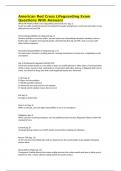Exam (elaborations)
American Red Cross Lifeguarding Exam Questions With Answers
- Course
- Institution
American Red Cross Lifeguarding Exam Questions With Answers What will American Red Cross Lifeguarding class teach you? (pg. 2) Teach you skills needed to prevent and respond to aquatic emergencies. Teach land and water rescue skills plus first aid and CPR Primary Responsibilities of Lifeguar...
[Show more]



